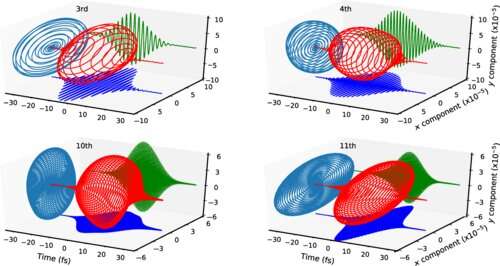This article has been reviewed according to Science X's editorial process and policies. Editors have highlighted the following attributes while ensuring the content's credibility:
fact-checked
proofread
A possible strategy for a tabletop chiral attosecond laser

When molecules form from many atoms, the atoms can combine in different ways. Two forms of the same molecule can have the same composition but have different arrangements of atoms, giving rise to isomers. Some isomers may have structures that are mirror images of each other. Such molecules are called chiral molecules. Scientists are interested in studying such molecules, for example, penicillin, because one arrangement can be a lifesaver while the other could be fatal.
Researchers shine extremely short pulses of light on molecules to take their videos during the processes of interest so that they can study the structure or formation of the molecule. The pulses are so short that they are measured in attoseconds. An attosecond is a billionth of a billionth of a second. The light needs to be what is called circularly polarized to study chiral molecules.
Different arrangements of a chiral molecule respond differently to circularly polarized light, making it possible to distinguish each arrangement. Though polarized attosecond pulses are a great tool for studying chiral molecules, generating such light pulses can be daunting, expensive, and needs bulky apparatus.
A new theoretical study by researchers from the Indian Institute of Technology Bombay, led by Prof Gopal Dixit, has suggested a scheme that makes it possible to have a compact tabletop source of circularly polarized attosecond laser pulses.
Their recipe suggests using a laser source with a single-and-double frequency pair of laser light shone on a solid material, such as graphene, to generate high-frequency short-duration pulses. The design does not pose any restriction on relative intensities of the single-and-double-frequency light. It is robust to any imperfections in the intensity of the light source.
Light is a transverse wave. Its S-shaped vibrations are perpendicular to the direction it travels; that is, the wave vibrates up and down as it travels. The vibrations could be vertical, horizontal or at any angle in between. When the angle of vibrations rotates clockwise or anticlockwise, as seen when looking into the direction of propagation, the light is called circularly polarized. The light is said to have right or left helicity.
Researchers use a phenomenon called high-harmonics generation to generate pulses a few attoseconds long. An intense laser pulse, called a driving field in this context, when shone on certain materials such as krypton gas, energizes the electrons in the krypton atom as they absorb the light. When the electrons return to rest, they emit radiation that contains high harmonics— frequencies that are a few hundred or even thousand times the frequency of the original laser.
As the frequency increases multifold, the length of the pulses reduces proportionally. We thus get extremely short pulses, a few attoseconds long.
However, there is a catch. Using a driving field laser pulse with circular polarization does not ensure circularly polarized attosecond pulses of sufficient intensity.
"To study phenomena involving chirality and magnetism, the helicity of light must be controllable. It becomes challenging to generate circularly polarized laser pulses useful to study these phenomena," explains Prof Dixit. Shining laser light on solid materials such as graphene instead of gases made it possible to obtain more intense pulses of circularly polarized light compared to those generated using gases. Using solids also offers additional control over the polarization of the emitted light pulses and enables a compact source.
An earlier scheme used a single and double frequency pair with opposite polarization to generate circularly polarized high-harmonics. This scheme gives light pulses pairs with polarization identical to the source pulses. The adjacent harmonic frequencies have opposite helicities (one follows the single-frequency helicity while the other follows the double-frequency helicity).
But frequencies that are multiples of three times the source frequency are missing. Various schemes, such as varying the intensities of the frequencies in the source laser and introducing additional pulses with different polarization, did not provide a desirable control over the circular polarization of the attosecond laser.
The IIT Bombay scheme suggests using laser light with a single-and-double-frequency pair with the same circular polarization direction. The team has designed a specific scheme that uses single and double-frequency pair laser sources with no rotational symmetry. All the high harmonics generated using this design have identical helicity, irrespective of the relative intensities of the single and double source frequencies.
The researchers used computer simulations to observe the spectrum obtained by earlier schemes as well as their scheme. They observed that their scheme is robust against variations in the intensity and phase of the driving laser pulses. Their suggested scheme can be extended to other 2D materials with a hexagonal lattice and other solid materials. The researchers say their work can facilitate "observing chiral light-matter interactions in molecules and solids in their natural time- scale."
The paper is published in the journal Physical Review Applied.
More information: Navdeep Rana et al, Generation of Circularly Polarized High Harmonics with Identical Helicity in Two-Dimensional Materials, Physical Review Applied (2022). DOI: 10.1103/PhysRevApplied.18.064049
Provided by Indian Institute of Technology Bombay




















